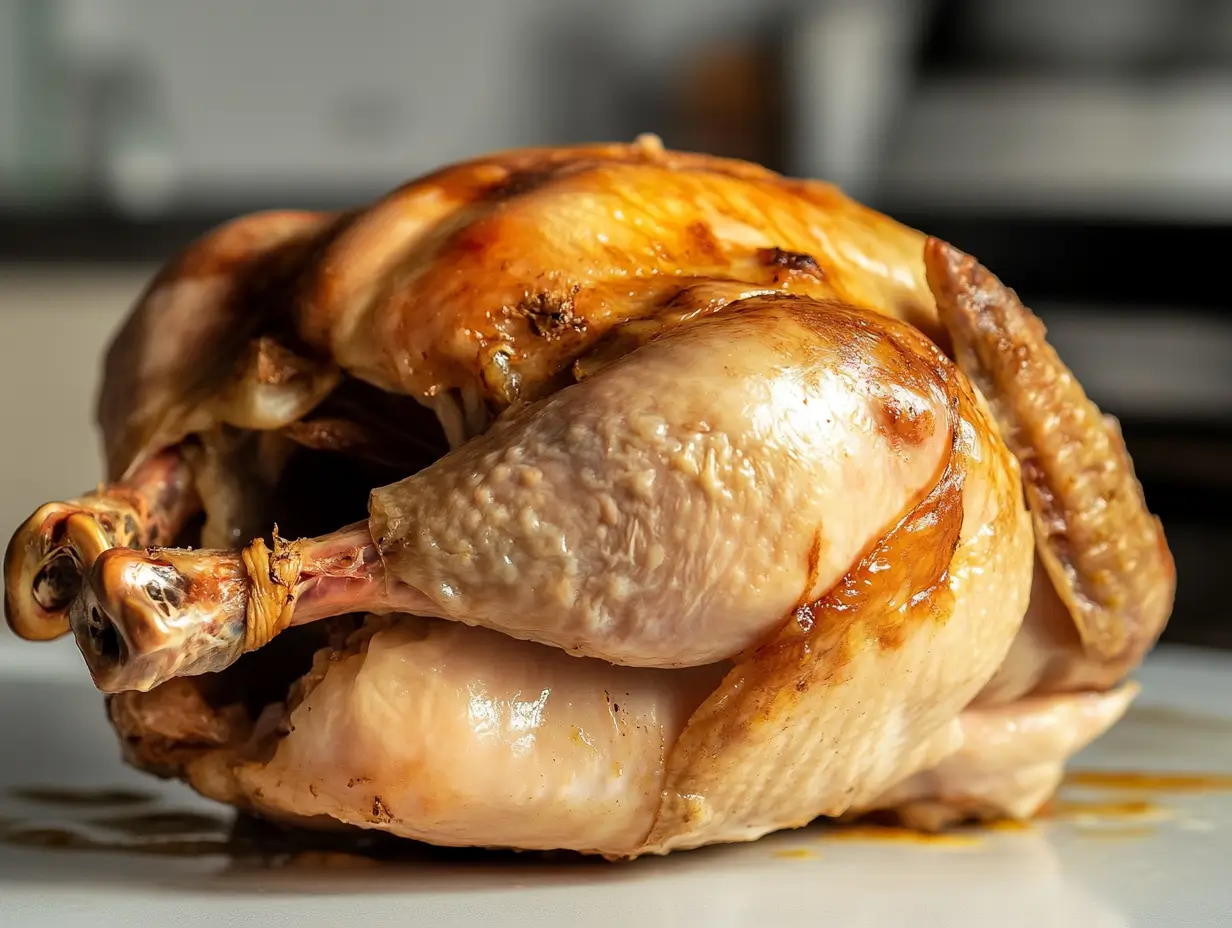As a busy parent, finding time to cook can be tough. That’s why rotisserie chickens from the store are a big help. But, have you wondered how long they stay good in the fridge? Knowing when a rotisserie chicken goes bad is key to keeping your family safe.
Let’s dive into how to tell if your rotisserie chicken is still good to eat. We’ll look at the signs that show it’s time to toss it
Understanding Rotisserie Chicken Safety Basics
Keeping rotisserie chicken safe is key to avoid foodborne illnesses. The United States Department of Agriculture (USDA) says to keep your fridge at 40°F or below. This keeps the chicken fresh and safe to eat.
The Two-Hour Room Temperature Rule
If you’re wondering how to know if rotisserie chicken has gone bad, start by considering how long it’s been at room temperature. Cooked chicken, including rotisserie chicken, should not sit out for more than two hours. If the temperature is above 90°F, this time drops to one hour. Leaving chicken out too long can promote harmful bacterial growth..
Importance of Proper Storage Containers
Sickrooms to vacuum pack or to store rotisserie chickens into airtight containers sealable bags keep it fresh from contamination. Cool the chicken before refrigerating. Keep it at safe temperatures.

By sticking to these chicken safety and storing rotisserie chicken tips, your leftover chicken will stay fresh and safe to eat.
Shelf Life of Rotisserie Chicken in the Refrigerator
A rotisserie chicken can stay fresh in the fridge for up to 4 days, says the USDA. This rule applies to all cooked chicken, whether bought, made at home, or from a restaurant. To keep your chicken fresh and safe, store it in a sealed container and mark it with the prep date.
If you can’t eat the chicken in 3-4 days, freeze it to keep it longer. Frozen rotisserie chicken can safely stay in the freezer for 4 months. This way, you can enjoy its taste and health benefits for months.
“Properly stored rotisserie chicken can last in the refrigerator for up to 4 days, according to the USDA.”
Another important aspect of how to know if rotisserie chicken has gone bad is understanding its shelf life. According to the USDA, cooked chicken can stay fresh in the fridge for up to four days. If it’s older than that, you should discard it. For longer storage, freeze the chicken, as frozen rotisserie chicken can last up to four months.

By following these tips for storing rotisserie chicken, you can enjoy its taste and health benefits. Check your chicken live for any signs of spoiled. If it looks or smells odd, toss it out.
How to Know If Rotisserie Chicken Has Gone Bad: Key Signs to Look For
It’s important to know if your rotisserie chicken has spoiled to avoid food poisoning. You can use your senses to spot the signs. Look out for these visual signs of spoilage:
- Mold growth on the surface
- Dark, green, or gray coloration
- White patches or yellowing skin
A bad or sour chicken smell test means the chicken has spoiled. Also, if the chicken feels slimy or sticky, it’s gone bad.
If you’re not sure, it’s safer to throw away the spoiled chicken. Eating chicken that’s gone bad can cause food poisoning and health issues.
“When in doubt, throw it out. It’s simply not worth the risk of consuming spoiled chicken.”
Remember, chicken color changes and chicken texture changes are key signs it’s time to throw it away. Trust your senses and avoid the risk of spoiled chicken.
Proper Storage Techniques for Maximum Freshness
Storage plays a big role in determining how to know if rotisserie chicken has gone bad. Proper storage includes:
- Take the chicken out of its original packaging. These containers aren’t airtight, which can cause it to spoil faster.
- Put the chicken in airtight containers or zip-top bags once it’s cooled down. This stops cross-contamination and keeps it fresh.
- Think about deboning or carving the chicken before you store it. It makes it simpler to control how much you eat and to get to the meat easily.
- Keep leftover bones and juices in a separate container. You can use them later for stocks, gravies, or other dishes.
By using these storage methods, you can keep your rotisserie chicken fresh and safe for a longer time. This way, you can enjoy it at its best.
“Proper storage techniques help maintain quality and prevent cross-contamination.”
Freezing Rotisserie Chicken for Extended Storage
If you’re unsure how to know if rotisserie chicken has gone bad, proper freezing can help. Follow these methods for safe storage:
Proper Freezing Methods
First, let your rotisserie chicken cool down completely. Then, wrap it tightly in plastic wrap or aluminum foil. Make sure to remove as much air as you can to avoid freezer burn.
Put the wrapped chicken in an airtight container or freezer-safe bag. Squeeze out any extra air and seal it well. Don’t forget to label the container with the date you froze it.
Maximum Freezer Storage Time
The USDA says frozen rotisserie chicken can last up to 4 months. For the best taste, try to eat it within this time. Shredded chicken or chicken dishes like soup or casseroles can last 4 to 6 months.
Preventing Freezer Burn
To avoid freezer burn, pack your chicken properly. Make sure to remove as much air as you can and seal it tightly. This keeps the chicken fresh and prevents freezer burn.
Also, try to keep your rotisserie chicken in the freezer for as short a time as possible. This helps it stay juicy and flavorful when you reheat it.
Safe Methods for Thawing Frozen Rotisserie Chicken
Thawing frozen rotisserie chicken safely from an FDA perspective protects the quality and the safety of the chicken. The chicken could simply thaw in the fridge, under cold running water, or in the microwave. Each method has its own benefits and things to consider.
Thawing in the fridge is the safest way. It takes 24 to 48 hours for a whole chicken. This slow thaw keeps the chicken’s taste and texture good. The USDA warns against thawing at room temperature to avoid bacterial growth.
Thawing under cold running water is quicker, taking just a few hours. But, you must change the water every 30 minutes to keep it cold. This stops bacteria from growing.
Using the microwave to thaw is faster but needs careful attention. It can cook parts of the chicken, creating hot spots for bacteria. Always cook the chicken right after thawing in the microwave.
It’s important to follow food safety rules when thawing and handling rotisserie chicken. Eating spoiled or thawed chicken wrong can cause serious health issues like Salmonella or Campylobacter infections. By being careful, you can enjoy your chicken safely and worry-free.
“Proper thawing of frozen rotisserie chicken is essential to prevent the growth of harmful bacteria and guarantee food safety.”
Reheating Safety Guidelines
When reheating your leftover rotisserie chicken, safety is key. Make sure to reheat it right and get it to 165°F. This kills any bacteria.
Oven Reheating Methods
The oven is perfect for a crispy skin and hot chicken inside. Put the chicken in a baking dish. Heat it at 400°F for 15 minutes, or until it’s 165°F inside.
Microwave Safety Tips
In the microwave, follow some important steps. Put the chicken on a microwave-safe plate in a single layer. Add oil or water to keep it moist. Cover with plastic wrap and heat in short bursts, checking the temperature often.
Stovetop Reheating Techniques
- Shredded or diced chicken is best for the stovetop.
- Use oil or broth to keep it moist and tasty.
- Heat it over medium, stirring now and then, until it’s 165°F.
No matter how you reheat, always check with a food thermometer. This makes your chicken safe to eat. It’s a simple way to enjoy your leftovers without worry.
“Proper reheating is essential for maximizing the safety and quality of your rotisserie chicken leftovers.”
Common Signs of Bacterial Contamination
Bacterial contamination in rotisserie chicken is a big health risk. Foodborne illnesses from Salmonella, E. coli, Staphylococcus aureus, and Campylobacter affect about 1 million people yearly in the U.S.
While spoiled chicken signs might not be easy to spot, there are important indicators. Look for color, texture, or odor changes. These signs mean the chicken is bad and should not be eaten. Eating chicken safety that’s contaminated can cause stomach pain, fever, vomiting, and diarrhea. So, it’s key to store and handle chicken right.
- A USDA study found 1 in 7 people still had germs in their sink after washing chicken.
- About 1 in every 25 chicken packages at the store have Salmonella, a big cause of foodborne illnesses.
- Bacteria grow fast between 40°F (4°C) and 140°F (60°C), known as the “Danger Zone.”
Spoiled cooked chicken might look slimy. Rinsing or reheating it doesn’t get rid of bacteria or toxins. It’s vital to watch for spoiled chicken signs and chicken safety to avoid health risks from eating contaminated chicken.
Health Risks of Consuming Spoiled Chicken
Consuming rotten chicken could result in grave health problems, ranging from food poisonings, which are often mild nausea and vomiting to extreme case signs such as dehydration, kidney failure, or even death. Small children, as well as those at the other end of life, pregnant women, and individuals with an immunocompromised state, are at the highest risk.
Putrid chicken comes with an observable fetid odor, slimy-to-sticky feel, and color alteration. If you see these signs, don’t eat the chicken. It might have harmful bacteria like Salmonella or Campylobacter.
“Leaving cooked chicken out for longer than two hours, especially overnight, increases the risk of harmful pathogens and toxins contaminating the meat.”
Storing and handling chicken safely will keep it from harm; cooked chicken should be put into the fridge within two hours-or one hour if still hot. Always reheat chicken to 165 degrees F to kill bacteria. Applying these tips will allow you to enjoy your chicken without ever worrying that it has gone bad.
Best Practices for Purchasing Fresh Rotisserie Chicken
When buying rotisserie chicken, picking the freshest one is key. Look for chickens that are hot and steaming. They should have a golden-brown, crispy skin. Stay away from chickens that have been on the warmer for too long. They might not be as fresh or flavorful.
Selection Tips at the Store
Go for the heaviest chicken you see. It’s usually the most tender and juicy. Check the labels for the chicken’s preparation date. This tells you how fresh it is. Watch out for reduced-price stickers. They might mean the chicken is close to being unsellable.
Transportation Safety
- When moving the chicken, remember chicken safety. If you’ll eat it in 2 hours, keep it hot (above 140°F).
- If you won’t eat it right away, cool it down (below 40°F) to stop bacteria growth. Use insulated bags or coolers, especially in warm weather.
By following these tips for buying and moving rotisserie chicken, you’ll enjoy a fresh, safe, and tasty meal every time.
Conclusion
Food safety concerns about spoiled rotisserie chicken are worth knowing by how to diagnose them. They include foul smell, slimy texture, or color changes. Always proper refrigeration in the refrigerator or freezer.
Follow safe thawing and reheating steps. This way, you can enjoy rotisserie chicken safely. If you’re unsure, it’s best to throw it away.
Leftover chicken can stay in the fridge for 3 to 4 days. Frozen chicken can last up to 4 months. Make sure it heats up to 165°F (74°C) to kill bacteria.
Signs of spoilage include a sour smell, sliminess, color changes, or mold. Use airtight containers and cool it down before refrigerating. This keeps your chicken fresh and safe.
By following these tips, you can enjoy rotisserie chicken’s taste and convenience. It’s all about keeping your health and well-being first.

